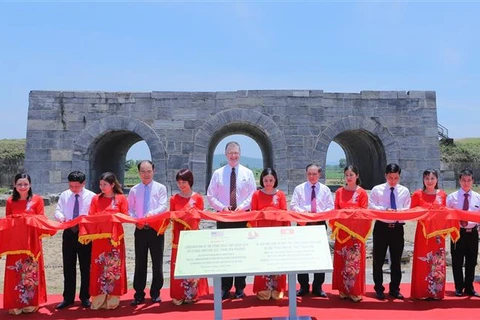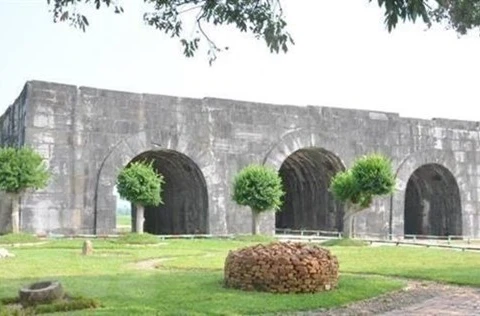Thanh Hoa (VNA) – Unique architecture traces have been detected at the centre of the Ho Dynasty Citadel, a UNESCO-recognised World Cultural Heritage site, during an excavation during the past two years, reported the Institute of Archaeology and the Ho Citadel Heritage Conservation Centre on December 14.
In the 2020-2021 period, the Institute of Archaeology and the Ho Citadel Heritage Conservation Centre have dug six excavation holes with a total area of 25,000sq.m.
The excavation has revealed four clusters of vestiges dating from the Tran Dynasty (1226-1400) and Ho Dynasty (1400-1407), and three architectural clusters of the Later Le Dynasty (1428–1788). Notably, architectural vestiges of the Tran - Ho dynasties were found in excavation holes in the central, Southeast and Southwest parts on an area of about 16,000sq.m.
According to archaeologists, the found vestiges are thought to belong to the main hall of the Ho Dynasty Citadel, the oldest main hall in Vietnamese ancient capitals discovered so far.
Chairman of the Vietnam Association of Archaeologists Tong Trung Tin said that this is the largest excavation in the history of archaeology in Vietnam in terms of area in one excavation. The discovery of more than 20 architectural works of different periods has confirmed the outstanding global values of the World Cultural Heritage site. The excavation also shows that more architectural relics are hidden under the Ho Dynasty Citadel.
Built in 1397 under the Ho Dynasty as the capital of Dai Ngu (then name of Vietnam), the citadel is unique for its outstanding construction technique which used large blocks of stone, weighing from 10 tonnes to 26 tonnes each, carefully shaped, interlocked and elevated to an altitude of about 10 meters.
The citadel served as a military stronghold to protect the country from invasion, thus becoming a symbol of patriotism and national pride, and a witness of Vietnamese history during the late 14th and early 15th century. For the past six centuries, however, the forces of nature took its toll on the site./.
In the 2020-2021 period, the Institute of Archaeology and the Ho Citadel Heritage Conservation Centre have dug six excavation holes with a total area of 25,000sq.m.
The excavation has revealed four clusters of vestiges dating from the Tran Dynasty (1226-1400) and Ho Dynasty (1400-1407), and three architectural clusters of the Later Le Dynasty (1428–1788). Notably, architectural vestiges of the Tran - Ho dynasties were found in excavation holes in the central, Southeast and Southwest parts on an area of about 16,000sq.m.
According to archaeologists, the found vestiges are thought to belong to the main hall of the Ho Dynasty Citadel, the oldest main hall in Vietnamese ancient capitals discovered so far.
Chairman of the Vietnam Association of Archaeologists Tong Trung Tin said that this is the largest excavation in the history of archaeology in Vietnam in terms of area in one excavation. The discovery of more than 20 architectural works of different periods has confirmed the outstanding global values of the World Cultural Heritage site. The excavation also shows that more architectural relics are hidden under the Ho Dynasty Citadel.
Built in 1397 under the Ho Dynasty as the capital of Dai Ngu (then name of Vietnam), the citadel is unique for its outstanding construction technique which used large blocks of stone, weighing from 10 tonnes to 26 tonnes each, carefully shaped, interlocked and elevated to an altitude of about 10 meters.
The citadel served as a military stronghold to protect the country from invasion, thus becoming a symbol of patriotism and national pride, and a witness of Vietnamese history during the late 14th and early 15th century. For the past six centuries, however, the forces of nature took its toll on the site./.
VNA






















